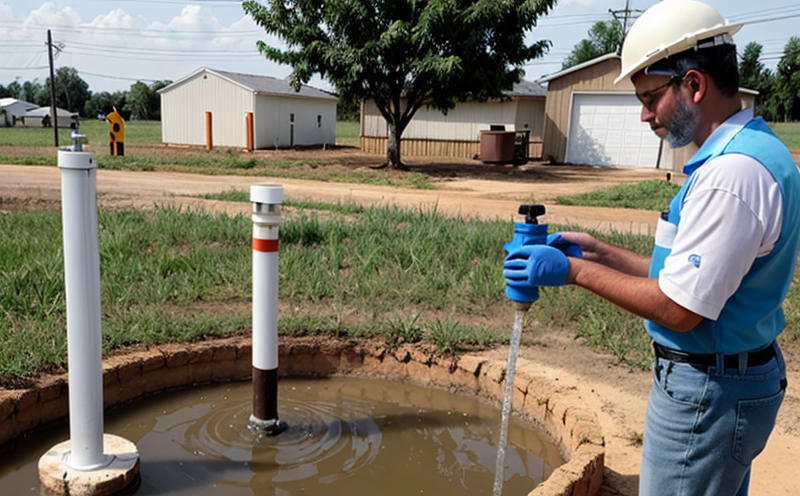ISO 15586 Mercury Testing by Atomic Absorption
The ISO 15586 standard specifies a method for determining trace amounts of mercury in water, soil, and solid materials using atomic absorption spectrophotometry. This technique is particularly valuable for groundwaters where mercury contamination can pose significant environmental and health risks.
Mercury testing by atomic absorption is crucial because even minute quantities of this heavy metal can have detrimental effects on ecosystems and human health. The method involves the reduction of metallic mercury to its gaseous state, which then interacts with a flame or graphite furnace where it is absorbed into an atomic vapor cloud. This process allows for accurate quantification using a photometer that detects light absorption at specific wavelengths.
The precision of this technique is enhanced by stringent quality control measures and the use of certified reference materials. The method is widely recognized in environmental and water quality testing sectors, making it a standard tool in laboratories worldwide. Compliance officers and R&D engineers often rely on these tests to ensure that groundwater meets regulatory standards.
The atomic absorption method follows ISO 15586 guidelines closely, providing reliable results even for trace levels of mercury. This makes the technique indispensable for industries such as water treatment, mining, and environmental remediation. Quality managers and procurement specialists benefit from this service by ensuring product integrity and compliance with international standards.
The process begins with specimen preparation, which involves diluting samples to appropriate concentrations. The specimens are then introduced into a flame or graphite furnace atomizer where the mercury is converted to its gaseous form. This step requires careful calibration of instruments to ensure accuracy. Once the sample vapor has been formed, it passes through the absorption cell where the degree of light absorption at 253.7 nanometers (the characteristic wavelength for mercury) is measured.
The results are analyzed using statistical methods to determine compliance with regulatory limits and internal quality control criteria. The laboratory ensures that all testing follows international standards such as ISO 15586, ASTM D2942, and EN 17376, providing clients with confidence in the reliability of their data.
Mercury contamination can arise from various sources including industrial discharges, atmospheric deposition, and natural processes. By employing this robust method, laboratories can help mitigate risks associated with mercury exposure, contributing to safer environments for all stakeholders.
Scope and Methodology
The ISO 15586 standard outlines a procedure for the determination of trace amounts of mercury in water, soil, and solid materials using atomic absorption spectrophotometry. The scope includes both liquid and solid matrices, making it versatile for various applications within the environmental sector.
| Application | Description |
|---|---|
| Groundwater Monitoring | Detecting trace levels of mercury to ensure compliance with EPA and WHO standards. |
| Mining Operations | Evaluating the effectiveness of remediation efforts by monitoring post-treatment samples. |
| Environmental Remediation | Assessing contamination levels before and after remediation projects to ensure successful cleanup. |
| Industrial Compliance | Verifying that industrial processes do not exceed permissible limits set by regulatory authorities. |
| Research and Development | Developing new techniques for mercury abatement or mitigation strategies. |
| Consumer Product Safety | Testing raw materials and final products to ensure they meet safety standards. |
The methodology involves several key steps: sample collection, preparation, atomization, absorption measurement, and data analysis. Each step is critical for obtaining accurate results that are both reproducible and reliable. The precision of the method is further enhanced by regular calibration checks and the use of certified reference materials.
For liquid samples, dilution factors are determined based on initial concentrations to ensure optimal atomization efficiency. Solid samples require thorough grinding and homogenization before extraction into a suitable solvent for analysis. The choice of solvent depends on the specific matrix being analyzed, ensuring minimal interference with the mercury signal.
The atomic absorption spectrophotometer used in this method is equipped with a high-resolution grating monochromator to minimize spectral interferences. This setup ensures that only the desired wavelength corresponding to the emission spectrum of mercury is detected. The instrument also features automatic background correction, which further enhances measurement accuracy.
International Acceptance and Recognition
The ISO 15586 standard for mercury testing by atomic absorption has gained widespread acceptance in numerous countries around the world. Its international recognition stems from its robustness, reliability, and compliance with environmental regulations.
Many regulatory bodies worldwide rely on this method as a key tool for monitoring mercury contamination levels in groundwater. For instance, the Environmental Protection Agency (EPA) of the United States and the World Health Organization (WHO) have adopted ISO 15586 guidelines to ensure that groundwaters meet health and safety standards.
The international acceptance of this method is further reinforced by its inclusion in multiple national and regional standards. In Europe, EN 17376 provides additional guidance for the implementation of ISO 15586, while similar standards exist in Asia and Africa. This broad recognition ensures that laboratories using this method are aligned with global best practices.
The widespread adoption of ISO 15586 also benefits industries by providing a consistent framework for mercury testing across borders. This consistency is particularly important for multinational corporations operating in multiple countries, as it simplifies compliance processes and reduces the risk of discrepancies between test results obtained at different locations.
Quality managers and R&D engineers appreciate this international recognition because it provides them with confidence that their data will be accepted by regulatory bodies globally. Compliance officers can use these test results to demonstrate adherence to international standards, thereby reducing the likelihood of legal challenges or sanctions.
The method's reliability is further enhanced by its compatibility with other analytical techniques such as cold vapor atomic absorption spectrometry (CV-AAS) and inductively coupled plasma mass spectrometry (ICP-MS). This versatility allows laboratories to choose the most appropriate technique based on sample type, concentration range, and cost considerations.





